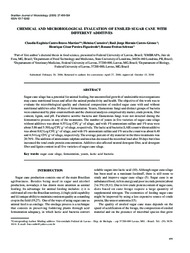Chemical and microbiological evaluation of ensiled sugar cane with different additives.
Chemical and microbiological evaluation of ensiled sugar cane with different additives.
Autoria: BRAVO-MARTINS, C. E. C.; CARNEIRO, H.; CASTRO-GÓMEZ, R. J. H.; FIGUEIREDO, H. C. P.; SCHWAN, R. F.
Resumo: Sugar cane silage has a potential for animal feeding, but uncontrolled growth of undesirable microorganisms may cause nutritional losses and affect the animal productivity and health. The objective of this work was to evaluate the microbiological quality and chemical composition of ensiled sugar cane with and without nutritional additives after 30 days of fermentation. Yeasts, filamentous fungi and distinct groups of bacteria were enumerated by plate count methods and the chemical analyzes comprised dry matter, crude protein, fiber content, lignin, and pH. Facultative aerobic bacteria and filamentous fungi were not detected during the fermentative process in any of the treatments. The number of yeasts in five varieties of sugar cane silage without additives was about 6.55 Log CFU g-1 of silage, and with 1% ammonium sulfate and 1% urea were about 5.86 and 5.50 Log CFU g-1 of silage, respectively. The lactic acid bacteria (LAB) count without additive was about 8.62 Log CFU g-1 of silage, and with 1% ammonium sulfate and 1% urea the count was about 6.40 and 6.54 Log CFU g-1 of silage, respectively. The average percent of dry material in the three treatments was 20.76%. The addition of ammonium sulphate and urea has decreased the microbial load after 30 days but it has increased the total crude protein concentration. Additives also affected neutral detergent fiber, acid detergent fiber and lignin content in all five varieties of sugar cane silage.
Ano de publicação: 2006
Tipo de publicação: Artigo de periódico
Unidade: Embrapa Gado de Leite
Palavras-chave: Cana de Açúcar, Fermentation, Lactic acid bacteria, Silage, Silagem, Sugar cane silage, Sugarcane, Yeasts
Observações
1 - Por padrão são exibidas publicações dos últimos 20 anos. Para encontrar publicações mais antigas, configure o filtro ano de publicação, colocando o ano a partir do qual você deseja encontrar publicações. O filtro está na coluna da esquerda na busca acima.
2 - Para ler algumas publicações da Embrapa (apenas as que estão em formato ePub), é necessário ter, no celular ou computador, um desses softwares gratuitos. Sistemas Android: Google Play Livros; IOS: iBooks; Windows e Linux: software Calibre.
Acesse outras publicações
Acesse a Base de Dados da Pesquisa Agropecuária (BDPA) para consultar o acervo completo das bibliotecas da Embrapa.

